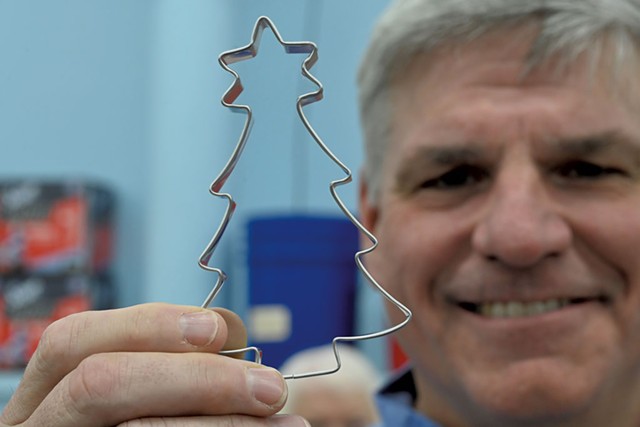
- Jon Olender
- Ben Clark holding a Christmas tree cookie cutter at Ann Clark's Rutland manufacturing facility
For many holiday bakers, the first step in the festive process is a trip into the depths of a forgotten cupboard. Behind lidless Tupperware and single-use appliances, they'll find a jumble of gingerbread people, stars and trees. And, if those cookie cutters are good ones, there's a high likelihood they were made in Vermont.
Inconspicuously tucked into the warehouse land of Rutland's Quality Lane, Ann Clark is the United States' largest producer of cookie cutters, selling 4 to 5 million per year. Founded in 1989 by the artist for whom it is named and now led by her son, Ben Clark, the company sits behind only Chinese mega-manufacturers on the global cookie cutter scale. And as it continues to grow, the family-owned operation is expanding into all aspects of the baking biz, from food coloring to cake mixes.
Cookie cutters are just one of the items that Ann's art inspired, Ben told Seven Days on a tour of the facility in early November. Recounting the company's history in a "quick five-minute pitch" that went on for much longer, the convivial CEO described a folksy drawing of a pig that his mother and his business-consultant father had made into cutting boards, Christmas tree ornaments, coasters and cookie cutters to sell at trade shows. The cookie cutter, with a handmade recipe card tied to it, was the runaway hit.
Soon, that pig was joined by a cow and a sheep. In those days, the family focused on selling their cookie cutters to gift stores and making custom promotional ones for businesses such as McDonald's and Under Armour. Now, Ann Clark has an arsenal of roughly 3,500 shapes — around 700 of which are currently available — that range from simple numbers to holiday staples to a "fashion doll head," which surged in sales this summer around the release of Barbie.
New shapes can be made in a day, inspired by trends, pop culture moments, competitors' products, and creative ideas from employees and bakers around the country. There's a cookie cutter for each of the year's "26 events," Ben said — a list that includes Christmas, Valentine's Day, Halloween and Discovery Channel's Shark Week.
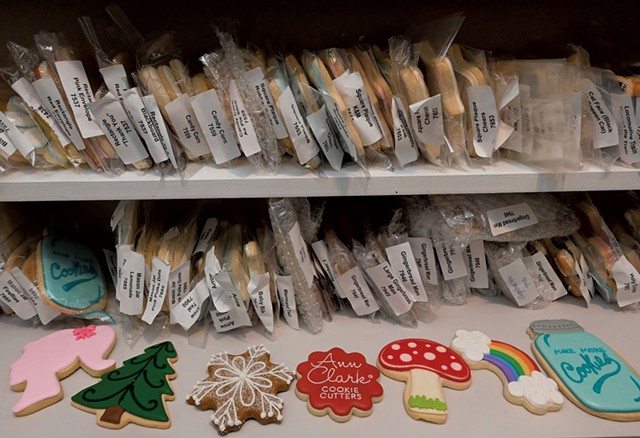
- Jon Olender
- The "cookie library"
Of all 3,500, Ann's favorite shape is the watering can. It became Ben's sentimental favorite, too, after they realized it was the company's worst seller. Any shape that does worse is immediately cut.
These days, Ann is semiretired, though she still comes to work more often than not, Ben said. At events such as CookieCon — an annual convention for cookie artists, who are known in the industry as "cookiers" — Ann is a celebrity.
"They go gaga over her," Ben said with a laugh.
The company works with many of the top cookiers in the world, who test new shapes and send their elaborately decorated samples to Ann Clark HQ. Digital content manager Annora McGarry catalogs them in a "cookie library" and stores the physical cookies in an office closet for use in photo shoots.
Ann Clark cookie cutters' high-profile fans include the team at King Arthur Baking in Norwich. The companies have worked together "for many years, and they are a wonderful partner," said Nathalie Morin, associate product manager at King Arthur.
Cookie cutter designs should have enough detail to be easy to decipher, without small, pointy elements that will make dough stick or overbake, she explained. Metal cutters make the crispest cut, and rolled edges make pressing down more comfortable.
"Ann Clark cutters check all the boxes," Morin said, "and we love the fact that they're made right here in Vermont."
The cutters' American-made status is a selling point for many, Ben said, but not always for the most obvious reason.
"We all think it's 'Buy America[n]' because we want to support America," he said. "It's really about lead time."
When a shape runs out at the Ann Clark factory, it takes the production team just about nine minutes to change the die — a heavy metal block in the shape of a cutter's final form — and start a replacement run. The new cutters are packaged and shipped by the following morning, whereas it could take months to import replacements from China, Ben said. During the busiest times of year, 12 to 15 employees across two shifts change dies 50 times a day, producing up to 500 cookie cutters per run.

- Jon Olender
- The shaping of a wise man cookie cutter
That approach, inspired by the principles of lean manufacturing, keeps just the right number of cutters on hand in the 17,000-square-foot facility.
With 3,500 dies and 10 pallets of metal on hand, the factory has the materials to produce 700,000 cookie cutters at any given time, Ben said. "But we don't have to have them [already] made."
Ann Clark's minimalist pick-and-pack warehouse mimics the layout of King Arthur's, which Ben toured when he was designing an efficient system. The most popular products are closest to the front, where they're easiest to grab.
When the business started, a company called Creative Products made the cookie cutters in Pennsylvania. Ann Clark slowly brought manufacturing in-house over the course of seven years, eventually acquiring Creative Products — and its accounts with stores such as Sur la Table, Williams Sonoma, Bed Bath & Beyond and Crate & Barrel.
"We realized we'd been trying to convince gift stores that a cookie cutter is a great gift," Ben said. "Every kitchen store already knows what a cookie cutter is and why it's great. We could barely keep up."
The increased demand from major kitchen and home stores created enough volume that it made sense to design and build a new machine to manufacture the cutters. Now on the fifth generation of machines, the factory is a one-stop cookie cutter shop.
A die-casting area anchors the back of the factory, churning out the forms that guide the company's 3,500 shapes — and any experimental ones in the development pipeline. To one side, two roll formers shoot out curl after curl of perfect-length tin-plated steel, which is then spot-welded into a ring.
Workers place those rings one by one on forming tables, which rapidly stamp the steel around the die into the desired shape. During a demonstration of the custom-built machine, a gingerbread man die — the mold for Ann Clark's top seller — waited like a contestant stuck to a Velcro wall on a Japanese game show. Ben placed the steel ring around it and hit the machine's glowing green button. Six strategically placed mechanical arms sprang into action and punched the steel ring into the nooks and crannies of the form. It took less than four seconds.
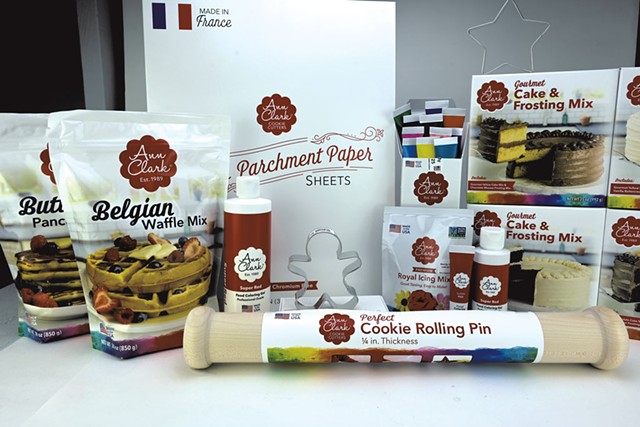
- Jon Olender
- A display of Ann Clark baking supplies
A small number of cookie cutters are purchased directly through the Ann Clark website, but most are sold wholesale or via Amazon, a retailer that the team started focusing on six years ago. Amazon's two-day shipping means that customers can order Sunday or Monday — the business' busiest days — and have the cutters by Wednesday, just in time to make cookies for a weekend birthday party. Ann Clark currently lists roughly 800 products there, from a simple heart cookie cutter to an 11-piece Under the Sea set with a shark, sea turtle and mermaid tail.
"Amazon opened up a whole 'nother world to what we could do," Ben said. "Now we're in 19 countries."
That success prompted a new question: What else do people who buy cookie cutters buy?
The team tested a host of private-label products, including food coloring, sprinkles, icing mix and meringue powder. The food coloring, like the pig design that launched a cookie cutter empire, was the clear winner. It kept selling out, and the manufacturer couldn't keep up. With the help of food scientists, the Ann Clark team developed its own recipe and built a separate, food-safe facility down the road.
That facility now produces 3,000 tubes of food coloring a day, along with products such as royal icing and fondant.
"The food coloring is amazing," said Paulina Thompson, who launched her Essex Junction home-based biz, Paulina's Sweets, in February 2021. "You can achieve the colors really fast, especially for that Christmas red that everybody wants. And it doesn't end up on my hands like other brands."

- Jon Olender
- Founder Ann Clark and her son, CEO Ben Clark
Thompson, who creates custom cookies and teaches decorating classes, has collaborated with Ann Clark to make demonstration videos. She likes to tell folks about Ann Clark during her classes, because "most people in Vermont don't know they're right here," she said. "In the cookier world, we definitely know about them."
The Ann Clark team assumed that its food coloring was mostly destined for that world, as a natural pairing for the cutters. But back-end data from Amazon revealed that 85 percent of its food coloring customers were new to the brand.
"We started asking, 'What do they do with the food coloring?'" Ben said. The answer? "Cakes."
That realization — and lots of tasting and recipe tweaking — led to a new line of cake mixes, set to launch in early 2024. Like other cookie-adjacent baking necessities Ann Clark has added over the years, such as instant royal icing mix, piping bags and parchment paper, they're meant to make things easy for novice bakers.
"When you're decorating cookies and baking cakes and trying to impress someone, it almost goes beyond food," McGarry said. "We want to help people tackle those momentous occasions with confidence."
And, McGarry pointed out, it doesn't cost much to nail those occasions, even if you're not a professional cookier. "You can make really good memories for under $10: $2.99 for a cookie cutter and $3.99 for a tube of food coloring," she said.
All you have to do is dig out the cookie cutters.

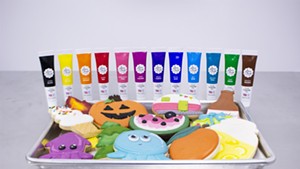
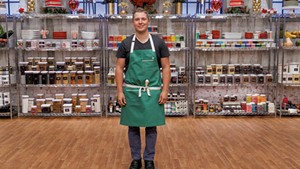
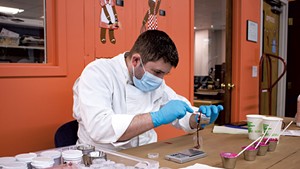
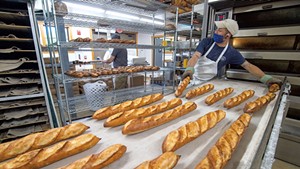









Comments
Comments are closed.
From 2014-2020, Seven Days allowed readers to comment on all stories posted on our website. While we've appreciated the suggestions and insights, right now Seven Days is prioritizing our core mission — producing high-quality, responsible local journalism — over moderating online debates between readers.
To criticize, correct or praise our reporting, please send us a letter to the editor or send us a tip. We’ll check it out and report the results.
Online comments may return when we have better tech tools for managing them. Thanks for reading.